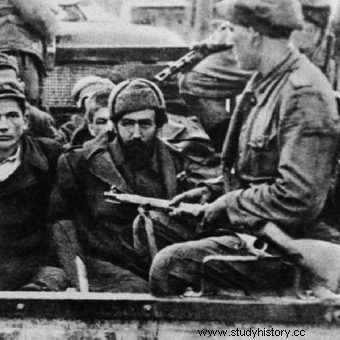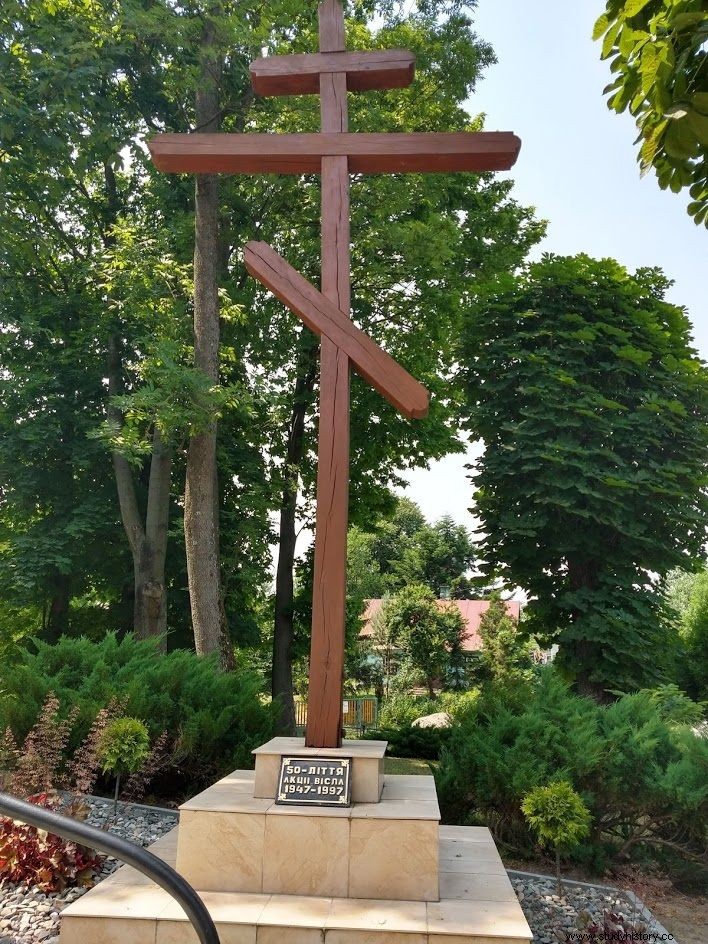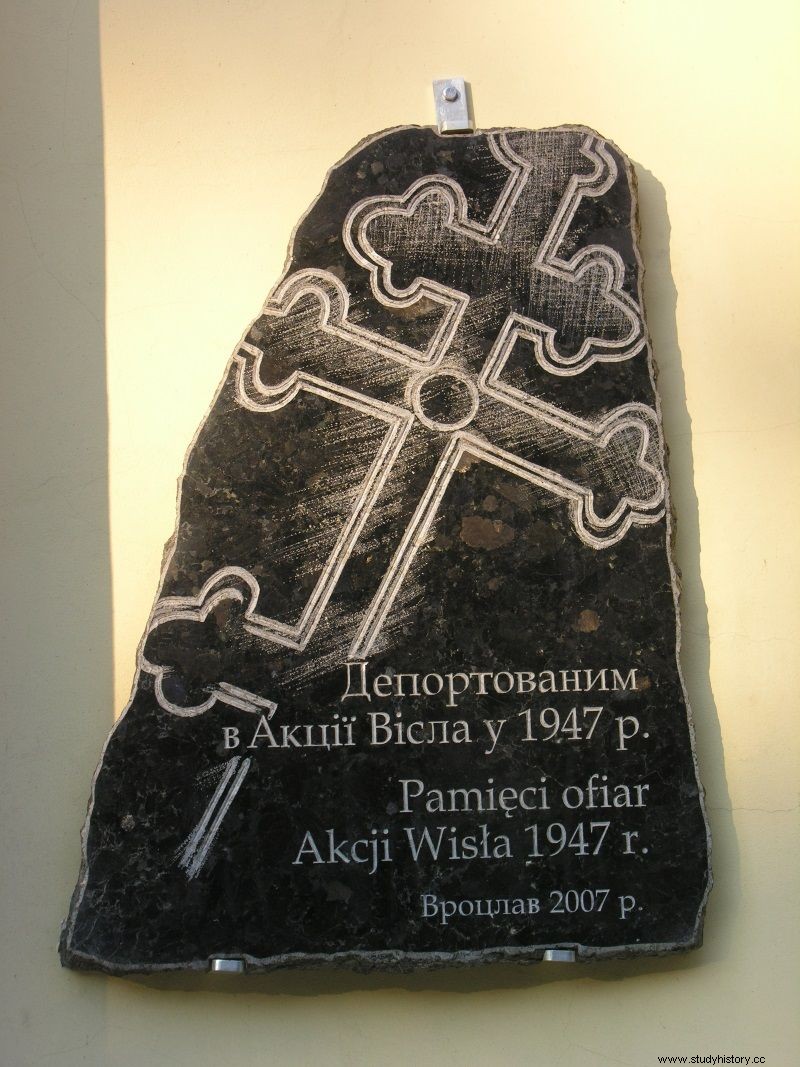The communist authorities of Poland achieved almost complete success. They carried out mass deportations of Polish citizens in Operation Vistula, then denationalized them, persecuted them and kept them under constant surveillance in order to intimidate them. But was it even necessary to fight the UPA?
Contemporary commentators, who did not take the trouble to find out about the history of south-eastern Poland shortly after the war, usually give two reasons for the commencement of the resettlement of Ukrainians. The first was to be the murder of General Karol Świerczewski, who died in an ambush organized by the UPA. The second reason for carrying out Operation Vistula was the Volhynian crime. However, these opinions do not stand up to the facts.

Operation "Vistula", April 1947 (photo:public domain)
Immediately after the so-called "Lublin Poland" was established, the concept of creating a nation-state in Poland emerged. To this end, it was necessary to "fix" the problem of minorities. The biggest problem arose in the case of Ukrainians, who lived within the country's borders around 650,000-700,000. Polish communists started with an agreement with the Ukrainian Soviet Socialist Republic (September 9, 1944) regarding population exchange.
To the Soviet "Paradise"
Initially, the departures were voluntary, but after only 80,000 Ukrainians left Poland, the right to choose ended. The authorities, dissatisfied with the results, called for help from the military. Ukrainians protested against the forced displacement, referring, inter alia, to the fact that they have lived in this place for generations and are Polish citizens, and therefore should be treated in accordance with the constitution. The communist authorities remained unshakable. The first stage of resettlement lasted until mid-1946 and involved approximately 480,000 people. The formal decision on the operation "Vistula" was made by the Political Bureau of the Central Committee of the Polish Workers' Party on March 29, 1947. It is assumed that the operation lasted from April 28 to the end of July 1947, although the last displacements took place in 1950. It is estimated that during the Operation "Wisła" mainly to the western and northern lands, about 140,000 people.

Cross in the village of Kalników, next to the Orthodox church. It was erected on the occasion of the 50th anniversary of Operation Vistula (photo:private archive)
The rulers believed that the Ukrainians who stayed in their homeland would be loyal to Poland. The "problem" of their presence was to disappear, moreover, because there were few of them left and they were scattered. In the Ukrainian context, the Ukrainian nationalist organization, the UPA, remained the biggest problem. The communists constantly worked to expand the administration and seal the borders. Adapting to the new realities, the command of the Ukrainian Insurgent Army in mid-1945 created a separate military district intended for operations in Poland, codenamed "San".
It is worth emphasizing here that after the population exchange with the USSR, the Ukrainian underground drastically lost its importance. According to the estimates of Wiesław Szota and Antoni Szczęśniak, included in their flagship work, Road to Nowhere, in 1946-1947, the UPA units in Poland numbered about 5,000 people (including 2.5-3 thousand armed and 3 thousand members of the civil network) .
Grzegorz Motyka gives even lower estimates, specifying the number of people in the units at 1.4-1.5 thousand soldiers and several hundred armed members of the civilian network. It was just over one percent of the remaining Ukrainian minority in Poland with about 150,000 people. Moreover, according to intelligence reports, these people did not feel like fighting at all. As we can read in Krzysztof Potaczała's book "Only stones have been left" :
From the information of the Operational Department of the 2nd Division of the Polish Army General Staff:"[...] UPA bands [...] are currently experiencing an ideological and organizational crisis, which largely weakens their political and terrorist activities. […] Among the “pits” there are frequent symptoms of desertion, controlled only by terror used by commanders. […] Banderites are usually physically exhausted and lousy […]. Kuren »Hrynia« conscripted Ukrainian youth. The conscription was compulsory, and the youth tried to hide in Polish villages. Currently, the UPA makes frequent attacks on the surrounding villages in order to obtain food, clothing and shoes.
Before the deportations of the Ukrainian population to the east, the UPA constituted a serious force, although not universally supported by civilians. With only 150,000 Ukrainians left in south-eastern Poland, its combat potential became residual.
The UPAs were hungry, stripped, their medical facilities were regularly broken up, and they were chased through the forests by Poles. Young men did not join the guerrilla ranks, and those from forced conscription were held in the ranks by the vision of a bullet to the head for desertion.
Against the UPA? Are you sure?
Some historians indicate that without the deportations carried out in 1947 as part of Operation Vistula, it would not have been possible to solve the problem of the Ukrainian armed underground. In his speech at the session of the Parliamentary Committee on National and Ethnic Minorities in 2007, Grzegorz Motyka, quoted by Krzysztof Potaczała, refutes this thesis, pointing to another reason for deportation.

Plaque commemorating the victims of the operation "Vistula" at the church of St. Wincentego in Wrocław (photo:Bonio, license CCA 3.0 U)
As he says, the communists took up the UPA only in 1947, because for years they had not paid attention to its activities, focusing their initiatives on the destruction of the Polish independence underground, i.e. the so-called cursed soldiers. Previously, they treated the activity of the UPA as not threatening the security of the state.
As emphasized by the displaced persons, whose statements Potaczała quotes in the book "Only Stones Left" , the authorities could immediately send regular and well-armed troops to the general crackdown with the Ukrainian underground, which would allow for a quick and complete breakdown.
In fact, the aim of the operation "Vistula" was not to combat the UPA, but the forced assimilation of the Ukrainian population. The authorities took care of this, among other things, scattering other families and existing neighbors as far apart as possible. In addition, it was reported among the population in the so-called Recovered Territories that Ukrainian bandits were quartered in their villages, thus fueling an atmosphere of fear and distrust.
Information sources:
- Action "Vistula". Documents and materials , ed. Eugeniusz Misiło, Ukrainian Archives 2013.
- Dudra S., Beyond the little homeland. Lemkos in the Lubuskie Region , Oficyna Wydawnicza ATUT 2009.
- Homa A., Activity of the Court and the Prosecutor's Office of the Military Operational Group "WIsła" in the light of the documents of the archives of the Krakow branch of the Institute of National Remembrance , Master's thesis written under the supervision of dr. hab. Jarosław Moklak, Krakow 2009.
- Huk B., Organizational structure of the Ukrainian underground in the Lemko region in 1945-1947 [in:] Lemkos, Boykos, Ruthenians - history, modern times, material and spiritual culture , vol. III, ed. S. Dudra, B. Halczak, R. Drozd, I. Betko, M. Śmigel ', Głogów 2010.
- Motyka G., From the Volhynia massacre to Operation "Vistula". Polish-Ukrainian conflict 1943-1947 , Wydawnictwo Literackie 2011.
- Memorable 1947 , ed. Maria E. Ożóg, Wydawnictwo Wyższa Szkoła Pedagogiczna, Rzeszów 2001.
- Pawlikowski G., National policy of the authorities towards the Ukrainian national minority in the Lubelskie Voivodeship (July 1944 - March 1947) , "Polityka and Society", no. 6/2009.
- Potaczała K., Only stones left. Operation "Vistula":expulsion and returns , Prószyński i S-ka 2019.
- Szcześniak A.B., Szota W. Z., Way to nowhere. The activities of the Organization of Ukrainian Nationalists and its liquidation in Poland , Publishing House MON 1973.
- Wiatrowycz W., The Second Polish-Ukrainian War 1942-1947 , Ukrainian Archives 2013.
Check where to buy “Only stones left. Operation "Vistula":expulsion and returns ":
